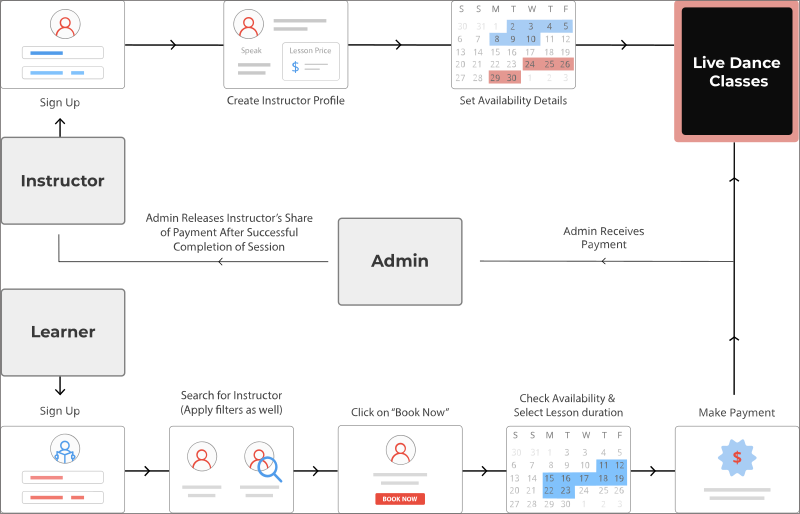The online dance learning industry is going through a massive digital revolution and virtual dance schools are taking center stage. According to the reports, the global online dance training market is expected to grow from USD 1.49 billion in 2023 to USD 5.33 billion by 2030, growing at a CAGR of 20% during the forecast period (2023-30).
Considering the growth, starting a virtual dance school like STEEZY, DanceBody, Dancio, and others can be a lucrative business venture. If you are an aspiring entrepreneur and want to create a platform that connects dance instructors with enthusiastic learners from every corner of the globe, you have reached the right place. In this blog, we will guide you through the process of starting a virtual dance school.
But first, let’s understand the benefits of starting a virtual dance school.
Table of Contents:
Benefits of Starting a Virtual Dance School
Virtual dance schools are on the rise. Following are the benefits you can expect if you decide to start a virtual dance school.
- Lower investment is needed as compared to traditional brick-and-mortar setups. No investment in renting or maintaining physical space, utilities, or other related expenses is required.
- A virtual dance school eliminates the geographical barrier, enabling the onboarding of instructors and learners across the globe.
- Virtual dance schools facilitate easy document sharing for future reference. Instructors can share resources, lesson plans, and more easily via a digital platform.
- Marketing a virtual dance school is comparatively easier than a traditional dance studio. You can market your school by utilizing social media, SEO strategies, and other digital marketing channels.
- With a virtual dance school, you can access multiple revenue streams which might not be possible in a traditional setup.
- Entrepreneurs can easily gain insights such as revenue reports, lesson statistics, and more through the admin dashboard and can measure the performance of their virtual dance school.
Next, let’s know about the popular players who have paved the way for themselves in the industry and are witnessing tremendous growth.
Popular Virtual Dance Schools
Following are some of the popular virtual dance schools:
Dance Masterclass
Dance Masterclass is an online dance training platform that connects dance enthusiasts with choreographers and dance instructors across the globe. This platform is popular among dance enthusiasts for its diverse offerings and sessions for all learners ranging from beginners to advanced levels. In December 2021, this dance learning platform raised EUR 400k from individual investors in venture funding.
Founder: Casper Hees
Year: 2021
Headquarters: Berlin, Germany
Revenue: Around $1 million per year
Steezy
This virtual dance school offers sessions in multiple dance styles ranging from house, dancehall, krump, breaking, whacking, and others. The platform offers step-by-step learning in a variety of dance styles and provides interactive features to enhance the learning experience.
Founder: Evan Zou and Connor Lim
Year: 2014
Headquarters: California, US
Revenue: $5 million per year
DanceBody
DanceBody is an online dance training platform that combines dance with fitness in the form of workouts. They offer different types of classes such as in-studio sessions, one-on-one personal training(in-home, in-studio, or virtually), and live on-demand classes and workouts. Many interactive features such as video conferencing, live chat, and others make it a popular choice among dance learners.
Founder: Katia Pryce
Year: 2013
Headquarters: New York, US
Revenue: $8 million per year
Dancio
Dancio is a popular dance learning platform that provides online dance classes taught by the best teachers from across the world. This platform offers sessions in multiple genres ranging from hip-hop, and ballet to contemporary and more.
Founder: Caitlin Trainor
Year: 2017
Headquarters: New York, US
CLI Studios
CLI Studios is an online dance training platform that connects 300+ world-renowned choreographers with dance enthusiasts. From beginners to advanced level, all types of learners are catered well on this platform. They offer sessions in three primary genres– ballet, modern, and contemporary. Along with the monthly and yearly subscriptions, they also offer bundles that are curated collections of 4-5 classes.
Founder: Jonathan Arpino
Year: 2014
Headquarters: California, US
Revenue: $6.6 million
Now that, you have gained insights about some of the popular players in the industry, the next crucial step is to gain an in-depth understanding of the business model of a virtual dance school. You must know how a virtual dance school works before starting your own.
Business Work Flow of A Virtual Dance School
A virtual dance school consists of three user types– learners, dance instructors, and admin.
Let’s understand the workflow of each user individually.
Learners
- First, learners register themselves on the platform by filling in their important details.
- Next, they log into the platform with their credentials and start searching for tutors.
- Based on their needs and preferences learners can choose dance instructors as per their calendar availability and book them by paying fees.
- Then, after the successful payment, learners can start their dance learning journey by attending online sessions on the platform.
Dance Instructors
- Dance instructors register themselves on the platform by filling in the necessary details.
- Next, they can create their profile by filling in important details like their dance education or certifications, location, availability, expertise, experience, and more.
- Instructors also need to set price and duration of the sessions.
- To receive their earnings hassle-free, the instructor must add their bank account details on the platform.
- Further, instructors get listed on the platform and are ready to take session bookings from the learners.
Admin
- Admin runs and manages all the operations of a virtual dance school. Admin is the mediator between learners and dance instructors and manages all the users on the platform.
- He is responsible for managing user accounts, registrations, profile management, instructor requests approvals, and more.
- Admin can manage sessions on the platform.
- Admin also handles the financial aspect of the virtual dance school. Once the session is completed successfully on the platform, the admin can deduct the commission and release the rest amount to the instructor.
- Moreover, the admin can also monitor the key performance factors such as user engagement, course popularity, instructor popularity, and revenue growth of the virtual dance school. With in-depth insights, the admin can make data-driven decisions to improve the performance of the virtual dance school.
- Further, to promote the platform, the admin can implement marketing strategies and other promotional activities. This ensures their virtual dance school is reaching the right target audience. It also includes managing, editing, and updating content on the platform.
After gaining insights on how a virtual dance school works? Next, let’s explore the necessary features of a virtual dance school.
Necessary Features For A Virtual Dance School
Features play an important role in simplifying your workflow and running your business more efficiently. You must consider this range of features to simplify and streamline your virtual dance school. Moreover, these features are very essential to provide an intuitive learning experience to learners on your platform.
- User Registration: Allow users to register hassle-free with minimum personal information or simply using email ID, phone number, or social media credentials.
- Attendance Tracking: This feature is essential to keep track of the students attending dance sessions. This also allows dance instructors to monitor participants effectively.
- User Management: User management enables admin to manage complete information including reviews, scheduled or completed sessions, and other specifications of all registered users on the platform.
- Content Management: With this feature, manage and update content in the form of blogs, newsletters, website content, and more on your platform.
- Session Scheduling: This feature is essential for ensuring a smooth session booking process. Learners can book and schedule sessions from the availability calendar.
- Refund Management: Admin can easily manage and process refund requests with refund management features.
- Orders Management: This feature enables the admin to manage all the orders (sessions/courses booked by learners) and view their complete details.
- Multiple Payment Options: Streamlining the financial transaction processes for users on your platform is very important. Offer multiple payment options such as debit cards, credit cards, net banking, mobile banking, eWallet, and others.
- Currency Management: This feature is very useful in serving the global audience base. The admin can add multiple currencies according to global standards and easily manage currency formats.
- Multilingual: This feature is essential to make your platform accessible to a global audience in different languages. Break the language barriers and cater to diverse learning styles with this functionality.
- Theme Management: With theme management features, the admin can manage and set the theme of the platform depending on its brand’s goals and identity.
- Certification Management: Provide certificates to learners upon successful completion of their courses or sessions on the platform. With this feature, enable your instructors to share certificates with learners.
- Reporting and Analytics: With robust reporting and tracking features, you can easily fetch the details related to sales, session bookings, cancellations, and much more. These insights and data can help you in making strategic decisions for your business growth.
- Communication Tools: Collaborative tools such as video conferencing, screen recording, screen sharing, live chat, and others are essential to make the process of learning dance more effective.
- Marketing Features: With these features, you can attract instructors and learners to your platform. Implement marketing campaigns, optimize SEO strategies, and use social media channels to increase the visibility of your virtual dance school.
- Reviews and Ratings: Ratings and reviews are instrumental in creating and maintaining your virtual dance school’s reputation in the market. It is important to build trust and credibility among your target audience. Moreover, it shows transparency and helps new students make informed decisions.
- Issue Resolution: The admin is responsible for resolving any issues that may arise during a learner’s journey in your virtual dance school. With this feature, all the reported issues and related details can be accessed in one place. Further, the admin can take action on the issues reported accordingly.
- Mobile Apps: User-friendly and intuitive mobile apps for learners enable users to access the platform through any other devices offering convenience and flexibility. This also supports their learning journey on the go.
After gaining insights about the necessary features of an online virtual school, the next important step is to understand how you can start and launch your own virtual dance school.
Launch an Advanced Virtual Dance School Equipped with the Latest Features
How to Launch a Virtual Dance School?
Starting a virtual dance school may seem like a daunting task in the beginning. However, with proper knowledge, and planning, this could be done easily. In this section, let’s understand step-by-step how you can start your virtual dance school hassle-free.
1. Conduct Market Research
The first and foremost step before starting a virtual dance school is to analyze the market. Gain knowledge about the key players, understand their strengths and weaknesses, and then implement those insights in your business. Further, study your target audience and understand their needs. The more you understand your market, the more you can cater to the pain points of your target audience.
2. Choose Business Model
After having a brief idea about the market, your target audience, and your competitors, you should choose a suitable business model. Business model can be decided based on your business idea and goals. Following are different types of business models that you can implement in your online dance learning business.
- One-on-one sessions: Offer learners a personalized learning experience and connect them in one-on-one sessions with dance instructors. These sessions can be tailored to the learner’s specific needs, and skill level, providing individual attention. Learners book session by paying a fee as stated by the instructor. Later, the admin cuts a commission from instructors’ fee.
- Group Classes: In this business model, the instructors teach multiple learners at the same time in a single class. The learners enroll themselves in the group dance session by paying a fee and later the admin releases the fee of the instructor after completion of the session.
- Live Course: Many learners want to sharpen their dancing skills step-by-step through continuous sessions for a long time. A dance school based on this business model enables learners to purchase a bundle of classes that are conducted live. The dance instructors conduct sessions and get paid by the admin after the completion of the sessions.
- Pre-Recorded Courses: The instructor creates, records, and uploads their video lectures in the form of a course on the platform. Learners who are seeking long-term training in any dance form and are looking for self-paced learning actively choose course-based learning. Learners purchase courses by making a payment and the admin earns a commission from the dance instructors fee.
Your virtual dance school can be structured around any business model or even a blend of multiple business models. The choice depends on your long-term business objectives and strategies. Further, let’s explore how you can ensure your venture turns out to be a profitable business.
3. Implement Diverse Revenue Streams
For the sustainable growth of your business, you need to implement diverse revenue streams in your virtual dance school. Some of the popular revenue streams are:
- Commissions: The admin charges a certain percentage of the commission fee cut from the instructors’ fee.
- Subscriptions: Learners pay a monthly or yearly subscription fee to avail of the services offered by the platform.
- Instructor listing fee: A fee can be charged to instructors for featuring them on the platform.
- Advertisements: Admin can charge a fee for showcasing advertisements on the platform.
After understanding different types of revenue channels, next, let’s know about the development approach that you can choose for starting your virtual dance school.
4. Determine The Development Approach
There are majorly two ways to build your virtual dance school. The first approach is to opt for custom development and the second approach includes choosing ready-made software. Let’s know about these development approaches in detail:
- Custom Development
In this development approach, you have to build your virtual dance school from scratch. A team of developers and designers would implement your business idea and build your virtual dance school platform. This process is a bit time-consuming and requires more effort and investment.
- Ready-made Software
Ready-made software is a pre-built solution that offers all the essential functionalities required to launch a successful virtual dance school. These software solutions often have years of development behind them and have been tested by many businesses already. So, you can trust and rely on these software solutions. Moreover, you can easily launch your virtual dance school without any technical knowledge. Ready-made software solutions are less expensive in the long run and require less time and effort as compared to custom development.
Planning to Launch An Advanced Virtual Dance School?
5. Market The Platform
Marketing and promoting your platform is fundamental in reaching out to your target audience, generating new clients, and eventually ensuring the success of your virtual dance school. This is the final and very important step after launching your virtual dance school.
Implement the following marketing strategies to promote your virtual dance school:
- Improve your virtual dance school’s visibility in search engine results by optimizing (Search Engine Optimization– SEO) your platform for relevant keywords related to virtual dance sessions. This makes it easier for your potential clients to find you online.
- Make a solid content marketing strategy and produce high-quality content such as blog posts, videos, tutorials, and others, and engage your target audience.
- Leverage various social media platforms like Twitter, Facebook, Instagram, and others to market your services.
- Attract new learners by organizing virtual dance workshops, masterclasses, or themed events on your platform.
- Collaborate with influencers, popular dance artists, or bloggers to expand your reach and attract new learners.
- Offer free trial sessions and discounts to new and existing clients attracting them to sign up for dance sessions offered in your virtual dance school. Moreover, allows existing clients to earn discounts and rewards.
- Encourage your students to leave positive reviews and testimonials for your services, and display them prominently on your platform and social media to build trust and credibility.
By following these marketing strategies you can effectively promote your virtual dance school. So, this was our comprehensive step-by-step guide to launch a successful virtual dance school. Follow these steps and launch your virtual dance school easily.
How Yo!Coach Can Help?
Yo!Coach is a cutting-edge ready-made software to launch your virtual dance school platform. This software offers all the essential features and functionalities that are required to successfully launch and run an online dance school. Moreover, it is fully customizable and highly scalable and caters to all your business needs efficiently.
Following are the advanced features offered by Yo!Coach:
- User-friendly UX/UI
- Collaborative tools for communication
- Advanced booking system
- Multiple payment options
- Multilingual
- Rating and reviews
- Reports and analytics
- Powerful admin features
- User management
- Marketing features
- Pre-integrated with 10+ APIs
Other benefits offered by Yo!Coach include:
- White-label
- No recurring charges
- Lifetime ownership
- Personalized demo
- Global clientele
- Top rated software
- Highly secure with GDPR-compliance
- 1000+ projects successfully delivered
Get a Walkthrough of Our Cutting-Edge Software
Conclusion
Launching a virtual dance school offers exciting opportunities for entrepreneurs looking to enter the online dance learning industry. Hopefully, the information mentioned above has provided you with practical knowledge that will assist you in getting started with your virtual dance school. You can easily embark on your entrepreneurial journey with the right insights, proper planning, and the latest technology.


